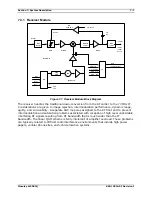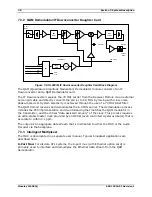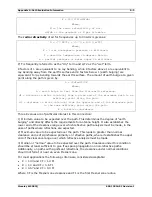
A-2
Appendix A: Path Evaluation Information
Moseley SL9003Q
602-12016-01 Revision J
direct signal, and may tend to add to or cancel the direct signal. The extent of direct signal
cancellation (or augmentation) by a reflected signal depends on the relative powers of the
direct and the reflected signals, and on the phase angle between them.
Maximum augmentation will occur when the signals are exactly in phase. This will be the
case when the total phase delay is equal to one wavelength (or equal to any integer
multiple of the carrier wavelength); this will also be the case when the distance traveled by
the reflected signal is longer than the direct path by an odd number multiple of one-half
wavelength. Maximum cancellation will occur when the signals are exactly out of phase, or
when the phase delay is an odd multiple of one-half wavelength, which will occur when the
reflected waves travel an integer multiple of the carrier wavelength farther than the direct
waves. Note that the first cancellation maximum on a shallow angle reflective path will
occur when the phase delay is one and one-half wavelengths, caused by a path one
wavelength longer than the direct path.
The direct radio path, in the simplest case, follows a geometrically straight line from
transmitting antenna to receiving antenna. However, geometry shows that there exist an
infinite number of points from which a reflected ray reaching the receiving antenna will be
out of phase with the direct rays by exactly one wavelength. In ideal conditions, these
points form an ellipsoid of revolution, with the transmitting and receiving antennas at the
foci. This ellipsoid is defined as the first Fresnel zone. Any waves reflected from a surface
that coincides with a point on the first Fresnel zone, and received by the receiving antenna,
will be exactly in phase with the direct rays. This zone should not be violated by intruding
obstructions, except by specific design amounts. The first Fresnel zone, or more accurately
the first Fresnel zone radius, is defined as the perpendicular distance from the direct ray line
to the ellipsoidal surface at a given point along the microwave path:
F1 = 2280 × [(d1×d2) / (f × (d1+d2))]½ feet
Where,
d1 and d2 = distances in statute miles from a given point on a microwave path
to the ends of the path (or path segment).
f = frequency in MHz.
F1 = first Fresnel zone radius in feet.
There are in addition, of course, the second, third, fourth, etc. Fresnel zones, and these can
be easily computed, at the same point along the microwave path, by multiplying the first
Fresnel zone radius by the square root of the desired Fresnel zone number. All odd
numbered Fresnel zones are additive, and all even numbered Fresnel zones are canceling.
A.1.4 K Factors
The matter of establishing antenna elevations to provide minimum fading would be
relatively simple was it not for atmospheric effects. The antennas could easily be placed at
elevations somewhere between free space loss and first Fresnel zone clearance over the
predominant surface or obstruction, reflective or not, and the transmission would be
expected to remain stable. Unfortunately, the effective terrain clearance changes, due to
changes in the air dielectric with consequent changes in refractive bending.
As described earlier, the radio beam is almost never a precisely straight line. Under a given
set of meteorological conditions, the microwave ray may be represented conveniently by a
straight line instead of a curved line if the ray is drawn on a fictitious earth representation of
radius K times that of earth's actual radius. The K factor in propagation is thus the ratio of
effective earth radius to actual earth radius. The K factor depends on the rate of change of
refractive index with height and is given as:
Summary of Contents for Starlink SL9003Q
Page 86: ...5 22 Section 5 Module Configuration Moseley SL9003Q 602 12016 01 Revision J ...
Page 90: ...6 4 Section 6 Customer Service Moseley SL9003Q 602 12016 01 Revision J ...
Page 110: ...A 10 Appendix A Path Evaluation Information Moseley SL9003Q 602 12016 01 Revision J ...
Page 118: ...D 2 Appendix D Microvolt dBm Watt Conversion 50 ohms Moseley SL9003Q 602 12016 01 Revision J ...
















































